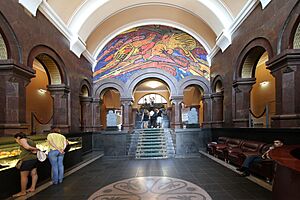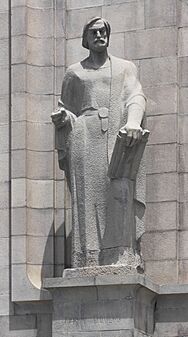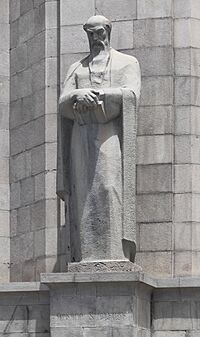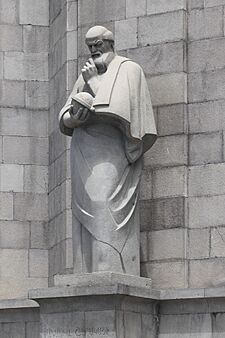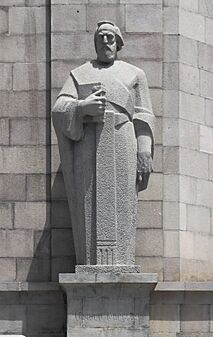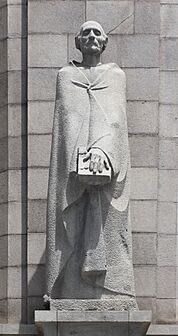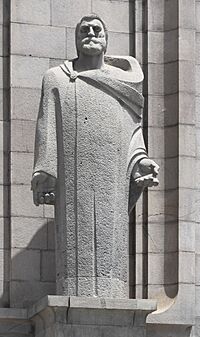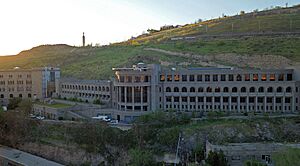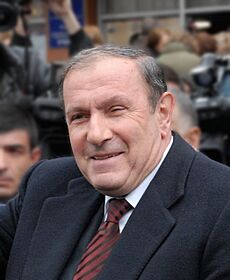Matenadaran facts for kids
 |
|

View of the Matenadaran
|
|
| Established | March 3, 1959 |
|---|---|
| Location | 53 Mashtots Avenue, Kentron District, Yerevan, Armenia |
| Type | Art museum, archive, research institute |
| Collection size | ~23,000 manuscripts and scrolls (including fragments) |
| Visitors | 132,600 (2019) |
| Architect | Mark Grigorian, Arthur Meschian |
| Owner | Government of Armenia, Ministry of Education and Science |
The Matenadaran (Armenian: Մատենադարան), officially called the Mesrop Mashtots Institute of Ancient Manuscripts, is a special museum, a place where old manuscripts are kept, and a research center in Yerevan, Armenia. It holds the largest collection of Armenian manuscripts in the world.
It started in 1959. Its first collection came from the Armenian Church in Etchmiadzin. Over time, more manuscripts were added, mostly from people who donated them. The Matenadaran is a famous building in Yerevan. It is named after Mesrop Mashtots, who created the Armenian alphabet. A statue of him stands in front of the building. The collection is so important that it is part of UNESCO's Memory of the World program.
Contents
What Does "Matenadaran" Mean?
The word matenadaran is made of two Armenian words: matean (meaning "book" or "parchment") and daran (meaning "repository" or "storage place"). Both words come from an old Persian language.
Even though some people translate it as "scriptorium" (a place where books are copied), a better meaning is "a place for storing or a library of manuscripts." In old Armenia, matenadaran meant a library because all books were handwritten.
Some other places around the world that keep Armenian manuscripts are also called matenadaran. To tell them apart, people often call this one the Matenadaran of Yerevan or the Mashtots Matenadaran.
A Look at Its History
Early Manuscript Collections
The first time a manuscript collection in Armenia was mentioned was in the 400s. A historian named Ghazar Parpetsi wrote about a collection at the Etchmiadzin Catholicosate. This was the main center of the Armenian Apostolic Church. It held both Greek and Armenian language texts.
Many large monasteries in medieval Armenia also had manuscript collections. Sometimes, manuscripts were even hidden in caves to protect them from invaders. Sadly, thousands of manuscripts were destroyed between the 900s and 1400s during invasions by Turkic and Mongol groups. For example, in 1170, the Seljuk Turks burned over 10,000 Armenian manuscripts in Baghaberd.
How the Collection Grew
The Matenadaran's collection started with the Etchmiadzin collection. This collection began in 1441 when the church leaders returned to Etchmiadzin. The Etchmiadzin Matenadaran was attacked and robbed several times. The last time was in 1804 during a war.
When Eastern Armenia became part of the Russian Empire in the early 1800s, it became safer to keep the manuscripts. In 1828, the collection had 1,809 manuscripts. By 1913, before World War I, it had grown to 4,660 manuscripts. In 1915, the collection was sent to Moscow for safety because Etchmiadzin was near the war zone.
Thousands of Armenian manuscripts were destroyed during the Armenian Genocide in the Ottoman Empire. However, about 1,600 were saved from different areas.
The Modern Matenadaran
On December 17, 1920, the new government of Armenia decided to take control of all cultural and educational places in Armenia. The manuscript collection at Etchmiadzin became "property of the working peoples of Armenia." In 1922, the manuscripts that had been sent to Moscow during World War I were brought back to Armenia. This added 1,730 manuscripts to the original collection.
In 1939, the entire collection was moved to the State Public Library in Yerevan. By then, there were 9,382 cataloged manuscripts.
On March 3, 1959, the Matenadaran was officially created as a "scientific research institute." It had special departments to preserve, study, translate, and publish manuscripts. In 1962, it was named after Mesrop Mashtots. It was the first place in the entire Soviet Union built specifically for studying and preserving manuscripts.
In 2015, a branch of the Matenadaran was opened next to the Gandzasar monastery in Artsakh.
The Matenadaran Building
Main Building Design
The Matenadaran building sits on a hill at the end of Mashtots Avenue in central Yerevan. It is about 18 meters (59 feet) above street level. It was designed by Yerevan's chief architect, Mark Grigorian, starting in 1939. Construction took place from 1945 to 1958.
The building is covered in local gray basalt stone. Its design is inspired by old Armenian architecture. Grigorian wanted the building to show off the "attractive features of national architecture." The front of the building looks like the eastern side of the 12th-century Church of the Holy Apostles in Ani, an old Armenian capital.
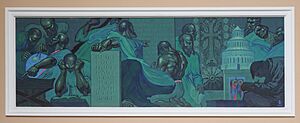
The inside of the building also takes ideas from medieval Armenian architecture. The entrance hall was inspired by the design of the Sanahin Monastery. Different types of marble were used inside.
There are three large murals inside, created by Van Khachatur in 1959. They show three periods of Armenian history: Urartu (an ancient kingdom), Hellenism (Greek influence), and the Christian Middle Ages. A mosaic by Khachatur from 1960 shows the Battle of Avarayr (451 AD) and is in the entrance hall.
The building is considered a national monument of Armenia. It was renovated in 2012.
Statues Outside
A statue of Mesrop Mashtots and his student Koryun was put up in 1962 below the main building. From 1963 to 1967, statues of six important medieval Armenian scholars were placed in front of the building. These scholars include Toros Roslin, Grigor Tatevatsi, Anania Shirakatsi, Movses Khorenatsi, Mkhitar Gosh, and Frik. They represent different fields like art, philosophy, history, and poetry.
-
Movses Khorenatsi
(Yerem Vardanyan, 1964) -
Mkhitar Gosh
(Ghukas Chubaryan, 1967) -
Frik
(Suren Nazaryan, 1967)
Since the 1970s, there has been an outdoor exhibit on both sides of the entrance. It displays medieval khachkars (carved cross-stones), an old tombstone, an ancient vishapakar (dragon stone), and a door from an Urartian archaeological site.
The New Building
A new building for the Matenadaran was designed by Arthur Meschian. It was needed to hold the growing collection of manuscripts. Construction started in 1987 but stopped due to an earthquake and economic problems.
The new building is five stories tall and much larger than the old one. It has a modern laboratory for preserving, restoring, and digitizing manuscripts. Meschian's design also uses ideas from traditional Armenian architecture, just like the old building.
The idea for the new building was brought back in 2008. Its foundation stone was laid in 2009. It received funding from Armenian businessmen. The new building was officially opened on September 20, 2011, just before Armenia's 20th independence anniversary.
Visiting the Matenadaran Museum
The Matenadaran has become a famous landmark in Yerevan and a popular place for tourists. Many people consider it Armenia's most important museum. In 2016, about 89,000 people visited, and in 2019, around 132,600 visitors came. Many important people from around the world have visited the Matenadaran.
The Matenadaran Collection
Today, the Matenadaran holds about 23,000 manuscripts and scrolls, including fragments. It is the largest collection of Armenian manuscripts anywhere. It also has over 500,000 other documents, like old decrees and historical papers.
The manuscripts cover many different topics. These include religious texts (like Gospels and Bibles), history, math, geography, astronomy, philosophy, law, medicine, music, and poetry. Writings by famous Armenian historians and thinkers are kept here. The works of Grigor Narekatsi and Nerses Shnorhali are very important for medieval Armenian literature.
The main part of the collection came from Etchmiadzin. Other parts came from different institutes and libraries.
When it became its own institution in 1959, the Matenadaran had about 10,000 Armenian manuscripts and 4,000 fragments. Some of these date back to the 400s. It also had about 1,000 manuscripts in other languages, such as Persian, Syriac, Arabic, Greek, and Georgian. Some original texts in other languages have only survived because they were translated into Armenian.
The number of manuscripts at the Matenadaran has grown steadily. Many have been given as gifts by people from the Armenian diaspora (Armenians living outside Armenia).
Special Manuscripts
Some of the most important manuscripts at the Matenadaran include the Lazarian Gospel (from the 800s), the Echmiadzin Gospel (from the 900s), and the Mughni Gospel (from the 1000s). The Echmiadzin Gospel, dated 989, has a beautiful carved ivory cover from the 500s. The illuminated manuscripts (books with colorful pictures) by Toros Roslin (1200s) and Sargis Pitsak (1300s) are also highly valued.
Three special manuscripts are allowed to leave the Matenadaran regularly. One is the Vehamor Gospel. It was given to the Matenadaran in 1975. It is probably from the 600s, making it the oldest complete Armenian manuscript still existing. Since 1991, every president of Armenia has taken their oath on this book. The other two, the Shurishkani Gospel (1498) and the Shukhonts' Gospel (1669), are taken to churches every year for people to honor.
Other Items in the Collection
Besides manuscripts, the Matenadaran also has a copy of the Urbatagirk, which was the first Armenian book ever printed (in 1512). It also has all the issues of Azdarar ("Herald"), the first Armenian magazine, published from 1794 to 1796. The first map printed in Armenian, from 1695, is also kept here.
Its Importance and Recognition
The Matenadaran is a "source of national pride" for Armenians. They see it as a place that holds their national heritage. In 1997, UNESCO added the Matenadaran collection to its Memory of the World Register. In 2011, Armenian President Serzh Sargsyan called the Matenadaran a "national treasure" and a "citadel of the Armenian identity."
During the Soviet era, the Matenadaran showed the high level of culture and learning that Armenians achieved long ago. It helped keep Armenian culture alive in an atheist state. Many people have called it a "modern, secular, and urban monastery" or a "chief temple" for Armenian manuscripts.
Karen Demirchyan, a Soviet Armenian leader, said that Armenian books and manuscripts were safe at the Matenadaran. He called it the "temple of priceless creations of the people's mind and talent."
Tributes and Recognition
In the Soviet era, the Matenadaran was featured on a and a  coin in 1990.
coin in 1990.
After Armenia became independent, the Matenadaran appeared on a 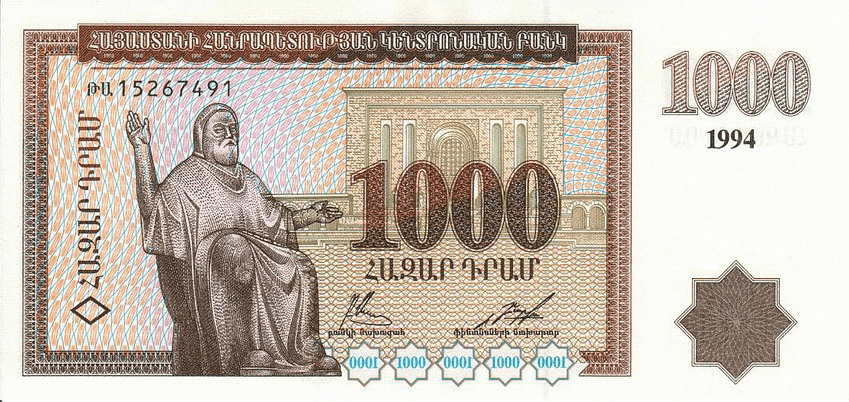 dram banknote from 1994 to 2004. It was also shown on special coins in
dram banknote from 1994 to 2004. It was also shown on special coins in 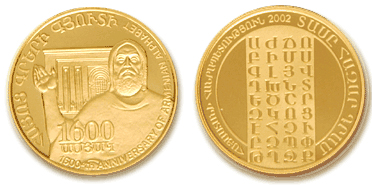 and 2007, and on a
and 2007, and on a 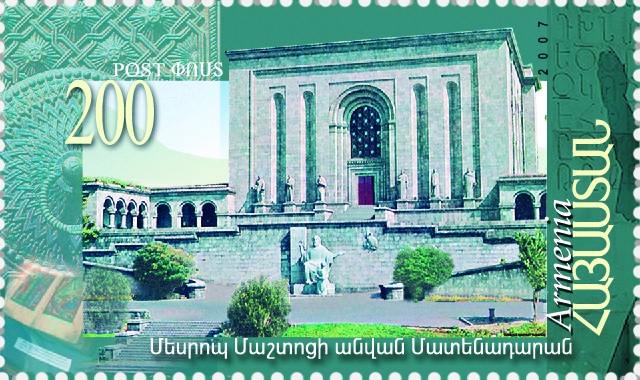 . In 2015, the Central Bank of Russia issued a coin that included the Matenadaran as a symbol of Yerevan.
. In 2015, the Central Bank of Russia issued a coin that included the Matenadaran as a symbol of Yerevan.
People Who Worked There
Directors
- Levon Khachikyan (1954–1982)
- Sen Arevshatyan (1982–2007)
- Hrachya Tamrazyan (2007–2016)
- Vahan Ter-Ghevondyan (2018–2023)
- Arayik Khzmalyan (2023–)
Notable Researchers
- Gevorg Emin: A famous poet who worked there briefly in the 1940s.
- Levon Ter-Petrosyan: The first President of Armenia (1991–1998). He worked at the Matenadaran from 1978 to 1991, starting as a junior researcher and becoming a senior researcher.
- Nouneh Sarkissian: The First Lady of Armenia from 2018 to 2022. She worked at the Matenadaran in the 1980s.
Images for kids
See also
 In Spanish: Matenadaran para niños
In Spanish: Matenadaran para niños




